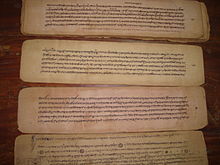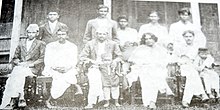Bengali literature
| Bengali literature বাংলা সাহিত্য | |
|---|---|
Alphabetic List | |
| Bengali writers | |
| Writers – Novelists – Poets | |
| Forms | |
| Novel – Poetry – Science Fiction | |
| Institutions and awards | |
| Literary Institutions Literary Prizes | |
| Related Portals Literature Portal Bangladesh Portal | |
| Part of a series on |
| Bengalis |
|---|
 |
Bengali literature (
Ancient

The first works in
Medieval (1200–1800)
Early medieval/Transitional (1200–1350)
This period is considered to be the time in which many common proverbs and rhymes first emerged. The Bengali alphabet became a lot like what it currently is. Ramai Pandit and Halayudh Misra were notable writers of this period.[3]
Pre-Chaitanya (1350–1500)
Muslim writers were exploring different themes through narratives and epics such as religion, culture, cosmology, love and history; often taking inspiration from or translating Arabic and Persian literary works such as the
Chandidas was the celebrated Hindu lyrical poet of this period, famed for translating Jayadeva's work from Sanskrit to Bengali and for producing thousands of poems dedicated to the love between Radha and Krishna such as the Shreekrishna Kirtana. Majority of Hindu writers in this period drew inspiration from a popular Maithili language Vaishnavite poet known as Vidyapati. Maladhar Basu's Sri Krishna Vijaya, which is chiefly a translation of the 10th and 11th cantos of the Bhagavata Purana, is the earliest Bengali narrative poem that can be assigned to a definite date.[6] Composed between 1473 and 1480 C.E., it is also the oldest Bengali narrative poem of the Krishna legend.[7][6] The Ramayana, under the title of Sri Rama Panchali, was translated by Krittibas Ojha.[8]
Late medieval era (1500–1800)

Bengali literature flourished in
Modern (1800–present)
The modern period of Bengali literature can roughly be categorized into six phases.[16]
- First phase: The era of prose (1800–1850). During this time, the Christian missionariesand Sanskrit-educated Bengali scholars worked to induce modernism through prose.
- Second phase: The era of development (1850–1900). During this time, pioneers like Bankim Chattapadhyay and Michael Madhusudan Datta, wrote novels and poems that exhibit Western influence. These classics remain masterpieces through test of time.
- Third phase: The era of Rabindranath Tagore (1890–1930). This period was dominated by Tagore's work and other works, especially poems, were subsumed by his influence.
- Fourth phase: The post-Rabindranath Tagore phase (1930–1947). During this time, many writers made a conscious effort to move away from the Rabindrik influence. This continued roughly until the partition of India.
- Fifth phase: The post-partition phase (1947–1970). After the partition, Bangla literature started developing separately in West Bengal and East Pakistan/Bangladesh focusing mostly view corresponding with on political and religious identities of each Bengal.
- Sixth phase: Bangladesh/West Bengal era (1971–present). After creation of Bangladesh in 1971, literature in Bangladesh was invigorated by writers like Humayun Ahmed, who built a new style of writing in simple language appealing to the masses.[17] Around the same time, West Bengali writers like Sunil Gangopadhyay, Samaresh Majumdar, and Shirshendu Mukhopadhyay, wrote with a fresh view of West Bengal in the era of globalization. As popular writers from this era demises, the literature created by the millennial era is yet to be characterized.
First and second phase (1800–1900)
The first Bangla books to be printed were written by Christian missionaries. were those by Christian missionaries. dom antonio's Brahmin-Roman-Catholic-Sambad, for example, was the first Bangla book to be printed towards the end of the 17th century. Bangla writing was further developed as Bengali scholars wrote textbooks for
The pre-Tagore era also saw an undercurrent of popular literature which was focused on daily life in contemporary Bengal. The prose style, as well as the humour in these works, were often crass, blunt and accessible. A masterpiece in this regard was "Hutom Pechar Naksha" (The Sketch of the Owl) written by Kaliprasanna Singha, and satirically depicts "Babu" culture in 19th century Kolkata. Other notable works in this regard are "Alaler Ghorer Dulal" (The Spoilt Brat) by Peary Chand Mitra, "Ramtanu Lahiri o tatkalin Banga shamaj" (Ramtanu Lahiri & contemporary Bengali society) by Shibnath Shastri and "Naba Babu Bilas" & "Naba Bibi Bilas" by Bhabanicharan Bandopadhyay. These books arguably portrayed contemporary Bengali dialect and popular society effectively, and also incorporated now-extinct music genres such as Khisti, Kheur and Kabiyal gaan by stalwarts like Rupchand Pakhi and Bhola Moyra. Books like these have become rarer since the emergence of Tagore culture, and the burgeoning preference for literary elegance and refinement in Bengali society.[20]
-
Bankim Chandra Chatterjee's first novel Durgeshnandini was considered a benchmark in the history of Bengali literature.[18]
-
Bengali Language Movement.
-
Kaykobad was a popular narrative poet.
-
Hason Raja's poetry continues to be prominent in rural Bengal.
Bankim Chandra Chatterjee's Vande Mataram played a vital role in the Indian independence movement and he is widely respected in India though less respected in Bangladesh his novels are popular in a lesser extent in Bangladesh.[citation needed] Bankim Memorial Award is the highest literary award which is given by the Government of West Bengal, India.
Third and fourth phases (1900–1947)


Short story writers
Bengali literature is also famous for short stories. Some famous short story writers are
Fifth phase: post-partition era (1947–1971)
Prakalpana Movement
Prakalpana Movement, branded by Steve LeBlanc, the noted US critic, as 'a tiny literary revolution', 'nurtured' by Kolkata, has been fostering its new genres of Prakalpana fiction, Sarbangin poetry and Chetanavyasism for over four decades, spearheaded by Vattacharja Chandan, beginning in 1969. It is probably the only bilingual (Bengali -English)
Sixth phase: two streams (1971–present)
Bangladesh stream
Humayun Ahmed, regarded as the Shakespeare of Bangladesh, created his own style of simplistic writing that became immensely popular. His characters like Himu, Misir Ali, Baker Bhai etc. continue to be household names loved by all. Other prominent writers include Muhammed Zafar Iqbal, Humayun Azad, Ahmed Sofa, Selina Hossain, Taslima Nasreen, and many others.[17] Waliullah Bhuiyan is one of the modern-era authors and publishers in the children literature of Bangladesh. His books and stories are some of the best-selling books in Bangladesh. He started Goofi Books – where he writes and publishes children books focusing on developing values, empathy, creativity among children.
West Bengal stream
West Bengal Bengali literature was influenced by a flock of modernist thinkers who steered Bangla literature. Sunil Gangopadhyay, a poet, novelist, and children's story writer, was one of the most prolific writers of his time. Satyajit Ray created his own detective Feluda, who is accompanied by Tapesh Ranjan Mitra, regarded by his nickname 'Topshe' by Feluda and Lalmohan Ganguly. Ray also created the characters Professor Shonku and Tarini Khuro, a revolutionary scientist and an adventurer and storyteller respectively. Additionally, others who left marks include Narayan Sanyal, Buddhadeb Guha, Mahashweta Devi, Nirendranath Chakraborty, Samaresh Majumdar, Samaresh Basu, Suchitra Bhattacharya, Purusottom Kumar Debnath, Nabaneeta Dev Sen, Syed Mustafa Siraj, Baren Gangopadhyay, Amiya Bhushan Mazumdar, Debesh Roy, Atin Bandyopadhyay, Shankha Ghosh, Shakti Chattopadhyay, Moti Nandi, Kamal Kumar Majumdar, Shankar, Malay Roy Choudhury, Bani Basu etc.
See also
- List of Bengali Poets
- List of notable writers
- List of Bengali-language authors (chronological)
- List of Bengali-language authors (alphabetical)
- Dalit Literature in Bengali
- Bengali novels
- Ghosts in Bengali culture
References
- ISBN 9789840414215.
- ISBN 81-7201-107-5.
- OL 30677644M. Retrieved 19 April 2024.
- ^ "The development of Bengali literature during Muslim rule" (PDF). Archived (PDF) from the original on 9 August 2017. Retrieved 22 September 2017.
- ^ "Sufi Literature". Banglapedia. Archived from the original on 11 September 2016.
- ^ ISBN 81-7201-107-5.
- ^ Ahmed, Wakil (2012). "Maladhar Basu". In Islam, Sirajul; Jamal, Ahmed A. (eds.). Banglapedia: National Encyclopedia of Bangladesh (Second ed.). Asiatic Society of Bangladesh.
- ISBN 81-7066-966-9, pp.105–10
- OCLC 246442470.
- ISBN 978-0-19-513901-3.
- ISBN 978-1556591969.
- ISBN 978-9846030679.
- JSTOR 41389881.
- ISBN 81-7215-301-5, pp.23–33
- OL 30677644M. Retrieved 19 April 2024.
- ^ "Bangla Literature". Banglapedia. Retrieved 28 April 2022.
- ^ a b "How Humayun Ahmed became the Shakespeare of Bangladesh". Daily Sun. Retrieved 28 April 2022.
- ^ ISBN 81-7201-107-5.
- ^ Deepa Bandopadhyay. নারীর লেখা নারীর কথা. Kali O Kalam (in Bengali). Archived from the original on 19 May 2015.
- ^ "Mechanicalcutta: Industrialisation, new media in the 19th century" (PDF). Archived from the original (PDF) on 5 July 2010. Retrieved 16 March 2010.
- ISBN 0-8248-1183-6.
- Times News Network. 3 April 2011.
- IBN Live. 8 May 2012. Archived from the originalon 10 May 2012.
- ^ "Mosquito and Other Stories by Premendra Mitra". Purple Pencil Project. 4 March 2019. Retrieved 9 June 2020.
- ^ ISBN 81-7955-007-9.
- ^ Adhya, Hemanta Kumar (2001). Rajshekhar Basu. Bharatiya Sahityakar Pustakmala (in Bengali) (1st ed.). Kolkata: Sahitya Akademi. 41-45.
- ^ "তিন বন্দ্যোপাধ্যায়ের দ্যুতি". 19 April 2021.
- ^ "Wildfire and Other Stories by Banaphool". Purple Pencil Project. 13 June 2020. Retrieved 5 July 2020.
- ^ Spectrum of Bengali literature (modern period), Indiaheritage.org, Retrieved 1 May 2007.
- ^ Ananta Ghosh, Great writers, Bengali Association of Greater Chicago Newsletter, Volume 25: Issue 2 : April 2000. Retrieved 1 May 2007.
- ^ Songs of Kobisena by Steve Leblanc in Version 90, PMS Cafe Press, Alston, MS, USA.
External links
- Library of Congress – Bengali Section
- An English Magazine on Bengali Literature by Sayeed Abubakar

![Bankim Chandra Chatterjee's first novel Durgeshnandini was considered a benchmark in the history of Bengali literature.[18]](http://upload.wikimedia.org/wikipedia/commons/thumb/7/72/Bankim_Chattapadhyay.jpg/82px-Bankim_Chattapadhyay.jpg)



